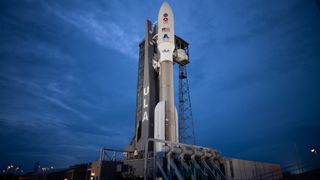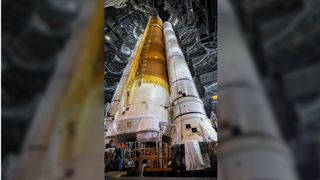
How do space rockets work without air?
Turns out, they still rely on combustion and Newton's third law of motion.

In space, rockets zoom around with no air to push against. What's their secret?
Turns out, the engines that power rockets are different than the kind of engines that power aircraft or other Earth-based equipment. Rocket engines carry everything they require into space, rather than relying on air.
Like Earthly engines, rocket engines operate using combustion. Since all forms of combustion need oxygen, rockets carry an oxidizer like liquid oxygen up to space with them. That means they don't have to rely on surrounding air like a car engine does.
"Then the rocket still has fuel, whether it's kerosene or methane or liquid hydrogen, to produce a reaction," Cassandra Marion, a science advisor to the Canada Aviation and Space Museum in Ottawa, told Live Science.
Related: Does the universe rotate?

The design of the rocket includes a combustion chamber, where the oxidizer and fuel react, and then a nozzle from which the combustion products emerge, she explained.
"The explosion caused by that combustion is going to create very hot gases, which are expelled out the bottom of a rocket," Marion said. "If you drive enough force out to the bottom of the rocket, the reaction is the rocket's movement in the opposite direction."
Sign up for the Live Science daily newsletter now
Get the world’s most fascinating discoveries delivered straight to your inbox.
That's a reference to Isaac Newton's third law of motion. We often phrase it to say that every action produces an equal and opposite reaction, although that is not exactly how Newton termed it.
One older English translation of his Latin from 1766's "The Mathematical Principles of Natural Philosophy (volume 1)" describes that law: "To every action there is always opposed an equal reaction: or the mutual actions of two bodies upon each other are always equal, and directed to contrary parts."
In other words, rockets are working in a universe of forces. Sometimes the forces are imbalanced, which we see as a rocket's acceleration pushes its inert body upward into space. Sometimes, however, forces are balanced, such as a book resting on a table (or a rocket waiting on the launch pad for its liftoff).
"According to the third law, the table applies an equal and opposite force to the book. This force occurs because the weight of the book causes the table to deform slightly so that it pushes back on the book like a coiled spring," Britannica wrote.

The rules of motion must also take into account orbital mechanics. Around large planets like Earth, simply put, every possible altitude has a particular speed associated with it.
The highest point of an orbit is a periapsis and the lowest point is an apoapsis. As NASA explained, rockets can only increase their periapsis by turning on their engines (or otherwise increasing their energy) while at apoapsis. Or if rockets want to lower their altitude, they need to remove energy (turn engines on) at periapsis.
Earth's atmosphere acts as a continual drag on spacecraft and the International Space Station, forcing them to fire rocket engines periodically to prevent falling back to Earth. So missions in all but the highest Earth orbits must carry enough fuel to prevent that "falling back" from happening.
"There are very precise measurements of how much fuel to put in the rocket, depending on the size of the rocket, the type of fuel and everything that adds into the mass of the rocket," Marion said. Designers must also take into account Newton's Second Law. One way of rephrasing it: Forces applied to an object give them acceleration, with the amount of acceleration dependent on the object's mass.

Before sending a craft into orbit, designers must therefore account for the specific impulse of a rocket. That is a measure of how efficient the rocket fuel is in terms of amount of thrust per amount of fuel burned, NASA said. "The higher the specific impulse, the more 'push off the pad' you get per each pound of fuel," the agency added.
Adding more fuel to a rocket isn't always the solution to dealing with orbital issues. That's because more fuel means more mass, which adds to the cost of a mission because it will take more energy to push the spacecraft and rocket off the launchpad.
NASA often uses liquid hydrogen and liquid oxygen, because that combination delivers the highest specific impulse of any commonly used rocket fuel, according to the agency. However, hydrogen has such a low density that it is impractical to use the propellant on its own: The tank would be "too big, too heavy and with too much insulation protecting the cryogenic propellant to be practical," the agency said.
That's why many launching rocket missions require boosters. One example today is NASA's Space Launch System, a deep space rocket for moon missions designed to use two boosters. Together, the boosters deliver 75% of the total launching thrust required to get the SLS off the ground.
For more distant destinations, space agencies get creative. To save on money when shooting for far-away planets such as Jupiter, some spacecraft whip around a planet (say, Venus) and use its gravity to get a speed boost. This shortens the time it takes to get to other destinations and requires a rocket to carry less fuel than required to go so far away.
Originally published on Live Science.

Most Popular

